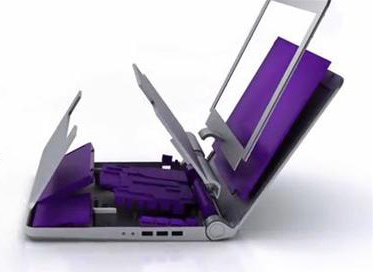Stanford students design laptop that breaks apart easily to aid recycling

If you want to take a look at a radical notebook design, feast your eyes on the Bloom laptop, a prototype that Stanford students designed to make it easier -- much easier -- to disassemble and recycle.
The impetus for the project is the fact that laptops are tightly assembled with screws and other adhesives keeping everything fitting together, which makes it difficult to break them down into their recyclable materials. The Bloom notebook features a 3D-printed plastic case with just a pair of knobs that opens up the system to let you easily remove the motherboard, battery, and other components. In a clever touch, a postage-paid envelope that resides behind the display is provided so you can send the parts to a recycling facility. You can then chuck the case in with your other plastic recyclables.
You can probably imagine -- as is the case with many "green" products -- that you'd make some sacrifices for a design like the Bloom laptop. Top-performing components wouldn't be the best fit since it's unclear how well the plastic case could stand up to the additional heat. The prototype is also slightly larger and heavier than an average laptop, so this isn't slim and sleek like a MacBook Air. But one advantage the design offers over typical notebooks is that the keyboard is detachable.
As you might suspect, there are no plans to bring the Bloom design to market, so the best we can hope for is that laptop manufacturers find inspiration from the prototype and try to integrate some of its ingenuity into their future notebook PCs.
[Via Technology Review]
